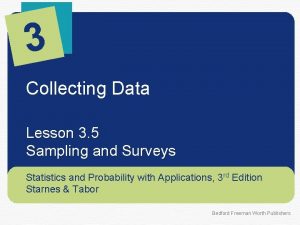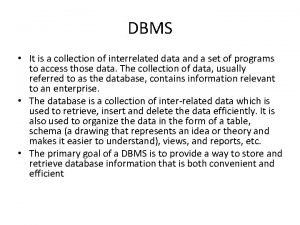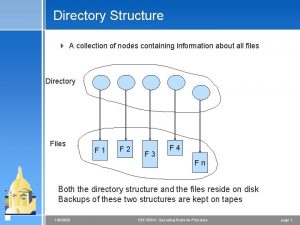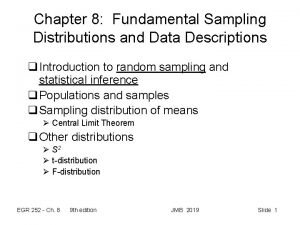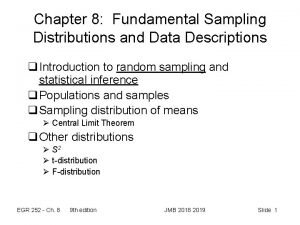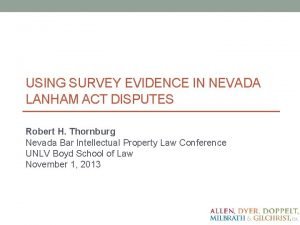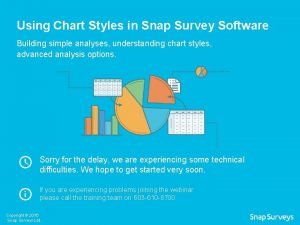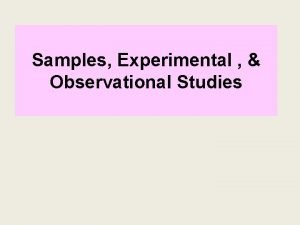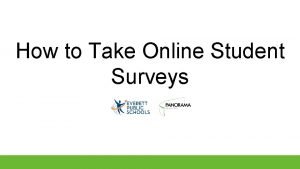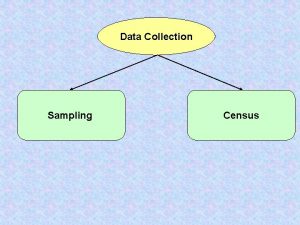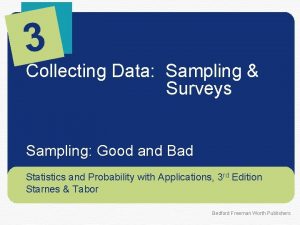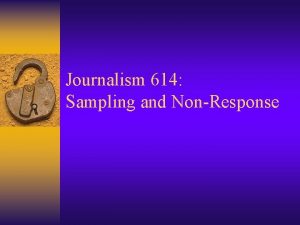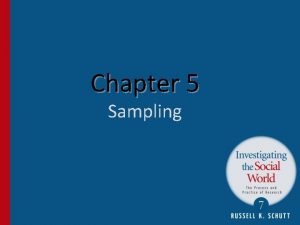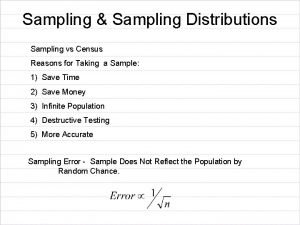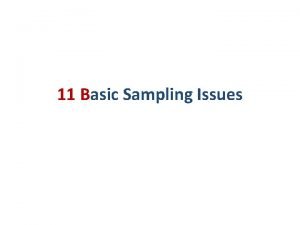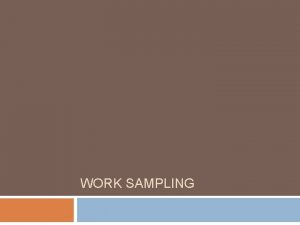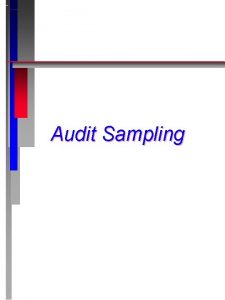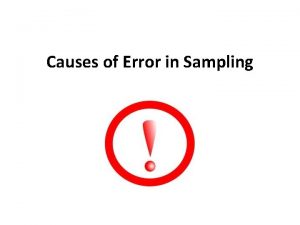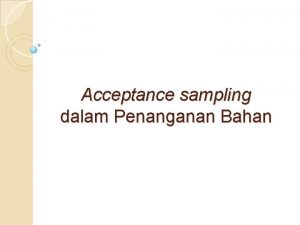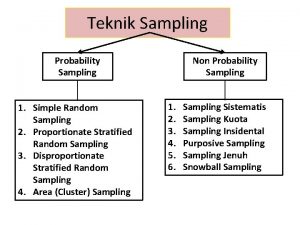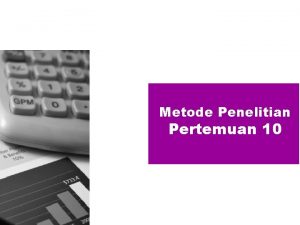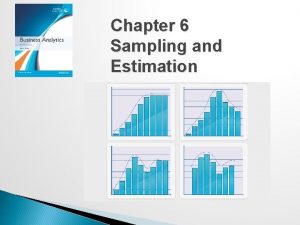Surveys Sampling Data Collection Surveys n Elicits information































- Slides: 31

Surveys Sampling & Data Collection


Surveys n Elicits information from patrons- might be factual, opinion, or both n Provides a quantitative or numeric description of trends, attitudes, or opinions of a population by studying a sample of that population § Creswell n Consistency of format and delivery n What is the purpose of the research? Why is a survey the appropriate tool?

Survey Types n Questionnaire n Paper-based (i. e. self-administered) n Can be administered to groups (e. g. , Class Evaluations) n Allows for clarification if necessary n Typically higher response rates n Interviews n Structured/ Formal n Identical questions n Identical delivery n Telephone or in-person

Surveys n Active n Mailed n By telephone n In-person interviewing n Distributed on location n Web/ Online n E-Mail/ Listserv n Passive n Comment Cards (surveys) are like bikinis. What they reveal is interesting, but what they conceal is essential. -Kenneth Boulding

Survey Design: Population/ Sampling n Define/ Enumerate Population n Literacy/ Language Issues n For self-administered n i. e. Children n Sample Selection n Who is the respondent/ unit? n Can they be found/ contacted? How? n i. e. unlisted numbers and random dialing What size sample is needed? n What response rate is acceptable? n

Surveys: Finding & Designing n Existing Instruments n Lib. Qual n WOREP n Library Research Services Web list n http: //www. lrs. org/us ersurveys. php n Design Templates n Surveymonkey n Zoomerang Advantages and Disadvantages?

Survey Design: Question Types n Dichotomous: Two possible responses (yes/no; true/false; male/female) n Have you used the public library in the past year? n Level of Measurement: Rank order or scale questions n Rank these library services in order of importance: availability of new releases, ability to renew online, new books on audio n Which library services do you use (check all that apply) n The library staff is helpful: Strongly Agree… n Filter/ Contingency Questions n If you answered no, skip to question 10… n Screening Questions n Have you ever taken an online tutorial?

Survey Questions n Types of Questions n Factual n Opinion/ Attitude n Self-perception n Information knowledge n Standards of action n Past or present behavior

Survey Design: Question Content n Are all questions useful/ necessary: level of detail n Do some questions need to be broken down further? n Avoid double-barreled questions n To cover all possibilities (i. e. do you use the library? Do you bring your children to the library? ) n To provide further context (have you ever used the archives? Was it for a school project or personal research? ) n To determine level of intensity (do you believe the public library is an important part of the community? Would you support increased funding? )

Survey Design: Question Content n Do respondents have necessary info to answer? (i. e. Is public funding adequate) n Should a question be more specific? n Difference between: did you like the book vs. did you recommend the book to others vs. will you read other books by the same author n Should a question be more general? (listing all services used vs. do you use the library at all)

Survey Design: Question Content n Are questions biased/ loaded? n Would you like increased evening/ weekend hours? Should the library eliminate overdue fines? n Will respondents be able (want) to answer truthfully?

Survey Design: Response Format n Structured Responses n Fill in the blank n Rating scales (placing items in order) n Check box n Single option (i. e. strongly agree…) n Multi-option (check all that apply) n n n Make sure all alternative as covered Treat all as separate variables Uniformity of options

Survey Design: Response Format n Unstructured Responses n Open-ended questions n Text-based responses n For interviews, must decide how to transcribe answers (i. e. every word/ general idea)

Survey Design: Question Wording n Can the question be misunderstood? n What sorts of online resources do you use? (do you mean general web, subscription database, for what purposes… research, entertainment, etc) n Does the question make assumptions? n Why do you use the library (assumes you do) n Is a time frame necessary and included n Should the library increase hours during exam time this year?

Survey Design: Question Wording n How personal? n Are library hours satisfactory vs. Do you feel library hours are satisfactory vs. Are you personally satisfied with library hours? n How direct? n What is your immigration status?

Survey Design: Question Wording n Define technical terms n Avoid jargon n Avoid offensive/ objectionable language

Survey Design: Question Placement n Ordering n Arrange by topic (do answers depend on prior questions) n Later questions may receive less attention/ interest n Opening questions n Set tone n Capture (or lose) interest n Sensitive questions n Attempt to establish trust, be non-threatening. Allow the option to not answer

Survey Design: Question Placement n Begin with easy, non-threatening questions n Do not begin with open-ended questions n Place more difficult questions later in survey n Stick to one topic at a time n Transition to new topics

Survey Design: Interviews n Role of Interviewer n Locate and enlist respondents n Motivate respondents to participate fully n Clarify and confusion n Observe the quality of the responses n Conduct a good interview

Survey Design: Interviews n Training n Describe study in detail (including purpose and objectives) n Be clear about sponsors of research n Instruct on survey research techniques/ rationale for questions n Explain interviewer bias and how to avoid it n Run through practice interviews

Survey Design: Interviews n Opening Remarks- gaining entry/ building trust n Explanation of research, purpose, goals n Stress confidentiality and voluntary nature n Stick to script but don’t be too formal n Ask questions exactly as written n In order n Ask every question n Provide clarification but not elaboration

Survey Design: Interviews n Probing: gaining adequate responses n Silence- can encourage people to talk more n Overt encouragement- nodding, saying okay etc. n Elaboration- i. e. asking “would you like to elaborate on that? ” n Asking for clarification n Repetition- repeat back an answer

Survey Design: Interviews n Recording responses n Take notes immediately n Include any probes/ clarifications n Use abbreviations

Survey Design: Interviews n Concluding the interview n Thank respondents n Tell them when they might expect results n Upon leaving, write down any notes/ observations

Survey Question Pitfalls n Poorly worded questions (ambiguous, broad, double-barreled) n Order of questions n Order of responses n Too many/ too few choices n Jargon n Differences in scale

Survey Issues n Self-reporting n Subjectivity n Response Rate n Respondent (Non-respondent) bias n Generalizing to a population

Surveys: Respect for Respondents n Remember respondents are doing you a favor n Be polite, courteous, always remember to thank them for participation n Offer to share results/ write-ups n Be as brief as possible n Be sensitive to respondents needs


Survey Questions: Samples n Compare: n Are you satisfied with our services? Y N n Which services have adequately met your needs? (Check all that apply) n How satisfied are you with xyz service? 1 2 3 4 Not at all Neutral Very 5

Survey Wrap-Up n Advantages and Disadvantages?
 Lesson 3.5 sampling and surveys
Lesson 3.5 sampling and surveys A dbms is a collection of interrelated data and
A dbms is a collection of interrelated data and How are qbe tools and sql similar
How are qbe tools and sql similar Probability sampling vs non probability sampling
Probability sampling vs non probability sampling Objective of sampling
Objective of sampling Cluster sampling vs stratified sampling
Cluster sampling vs stratified sampling Contoh event sampling adalah
Contoh event sampling adalah Stratified sample vs cluster sample
Stratified sample vs cluster sample Sampling in research
Sampling in research Natural sampling vs flat top sampling
Natural sampling vs flat top sampling Landsat collection 1 vs collection 2
Landsat collection 1 vs collection 2 D/a 30 days
D/a 30 days Research procedure in methodology
Research procedure in methodology Data collection secondary data sources
Data collection secondary data sources Collection of nodes containing information about all files
Collection of nodes containing information about all files Fundamental sampling distributions and data descriptions
Fundamental sampling distributions and data descriptions Fundamental sampling distributions and data descriptions
Fundamental sampling distributions and data descriptions Phases of data flow in environmental sampling
Phases of data flow in environmental sampling Fundamental sampling distributions and data descriptions
Fundamental sampling distributions and data descriptions Lanham act survey
Lanham act survey Snap surveys
Snap surveys Real eyes surveys
Real eyes surveys Observational study vs experiment worksheet
Observational study vs experiment worksheet Rebuttal surveys
Rebuttal surveys Purpose of security survey and inspection
Purpose of security survey and inspection Lit survey
Lit survey Surveys.panoramaed.com/everett
Surveys.panoramaed.com/everett Highway surveys
Highway surveys Partial discharge survey
Partial discharge survey What are surveys experiments or observation
What are surveys experiments or observation Syndicated data analysis
Syndicated data analysis Surveys.panoramaed.com/ecisd
Surveys.panoramaed.com/ecisd
